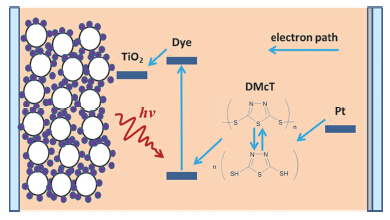| [1] O'Regan, B.; Grätzel, M. Nature 1991, 353, 737.
[2] Bach, U.; Lupo, D.; Comte, P.; Moser, J. E.; Weissortel, F.; Salbeck, J.; Spreitzer, H.; Grätzel, M. Nature 1998, 395, 583.
[3] Grätzel, M. Nature 2001, 414, 338.
[4] Hagfeldt, A.; Boschloo, G.; Sun, L.; Kloo, L.; Pettersson, H. Chem. Rev. 2010, 110, 6595.
[5] Chiba, Y.; Islam, A.; Watanabe, Y.; Komiya, R.; Koide, N.; Han, L. Y. Jpn. J. Appl. Phys. 2006, 45, 638.
[6] Yuan, Q.; Chen, X. J.; Wang, J. T.; Zhai, J. Acta Chim. Sinica 2014, 72, 624. (苑琪, 陈雪景, 王京涛, 翟锦, 化学学报, 2014, 72, 624.)
[7] Cao, Z. C.; He, Z.; Deng, L. J.; Tan, S. T. Chin. J. Org. Chem. 2014, 34, 340. (曹镇财, 何舟, 邓利军, 谭松庭, 有机化学, 2014, 34, 340.)
[8] Wang, J. W.; Li, Y.; Xu, Y. L.; Li, Y.; Shen, K. H. Acta Chim. Sinica 2012, 70, 1278. (王纪伟, 李莹, 徐艳玲, 李杨, 申凯华, 化学学报, 2012, 70, 1278.)
[9] He, J. J.; Chen, S. X.; Wang, T. T.; Zeng, H. P. Chin. J. Org. Chem. 2012, 32, 472. (何俊杰, 陈舒欣, 王婷婷, 曾和平, 有机化学, 2012, 32, 472.)
[10] Yum, J. H.; Baranoff, E.; Kessler, F.; Moehl, T.; Ahmad, S.; Bessho, T.; Marchioro, A.; Ghadiri, E.; Moser, J. E.; Yi, C.; Nazeeruddin, M. K.; Grätzel, M. Nat. Commun. 2012, 3, 631.
[11] Yella, A.; Lee, H. W.; Tsao, H. N.; Yi, C.; Chandiran, A. K.; Nazeeruddin, M. K.; Diau, E. W.; Yeh, C. Y.; Zakeeruddin, S. M.; Grätzel, M. Science 2011, 334, 629.
[12] Boschloo, G.; Hagfeldt, A. Acc. Chem. Res. 2009, 42, 1819.
[13] Wang, M. K.; Chamberland, N.; Breau, L.; Moser, J. E.; Humphry-Baker, R.; Marsan, B.; Zakeeruddin, S. M.; Grätzel, M. Nat. Chem. 2010, 2, 385.
[14] Tian, H. N.; Jiang, X. A.; Yu, Z.; Kloo, L.; Hagfeldt, A.; Sun, L. Angew. Chem., Int. Ed. 2010, 49, 7328.
[15] Li, D.; Li, H.; Luo, Y.; Li, K.; Meng, Q.; Armand, M.; Chen, L. Adv. Funct. Mater. 2010, 20, 3358.
[16] Tian, H. N.; Yu, Z.; Hagfeldt, A.; Kloo, L.; Sun, L. J. Am. Chem. Soc. 2011, 133, 9413.
[17] Daeneke, T.; Kwon, T. H.; Holmes, A. B.; Duffy, N. W.; Bach, U.; Spiccia, L. Nat. Chem. 2011, 3, 211.
[18] Bai, Y.; Yu, Q. J.; Cai, N.; Wang, Y. H.; Zhang, M.; Wang, P. Chem. Commun. 2011, 47, 4376.
[19] Liu, M.; Visco, S.; De Jonghe, L. C. J. Electrochem. Soc. 1991, 138, 1896.
[20] Oyama, N.; Tatsuma, T.; Sato, T.; Sotomura, T. Nature 1995, 373, 598.
[21] Xiao, L. X.; Hou, T. L.; Guo, B. K.; Oyama, N. J. Central South Univ. (Sci. Technol.) 2004, 35, 774. (肖立新, 侯桃丽, 郭炳焜, 小山昇, 中南大学学报(自然科学版), 2004, 35, 774.)
[22] Wang, L.; Wu, M.; Gao, Y.; Ma, T. Appl. Phys. Lett. 2011, 98, 221102.
[23] Wu, H.; Lv, Z.; Chu, Z.; Wang, D.; Hou, S.; Zou, D. J. Mater. Chem. 2011, 21, 14815.
[24] Wang, M.; Moon, S. J.; Zhou, D.; Le Formal, F.; Cevey-Ha, N. L.; Humphry-Baker, R.; Grätzel, C.; Wang, P.; Zakeeruddin, S. M.; Grätzel, M. Adv. Funct. Mater. 2010, 20, 1821.
[25] Wang, Q.; Moser, J.-E.; Grätzel, M. J. Phys. Chem. B 2005, 109, 14945.
[26] Fabregat-Santiago, F.; Bisquert, J.; Cevey, L.; Chen, P.; Wang, M.; Zakeeruddin, S. M.; Grätzel, M. J. Am. Chem. Soc. 2009, 131, 558.
[27] Fabregat-Santiago, F.; Bisquert, J.; Palomares, E.; Otero, L.; Kuang, D.; Zakeeruddin, S. M.; Grätzel, M. J. Phys. Chem. C 2007, 111, 6550.
[28] Koh, J. K.; Kim, J.; Kim, B.; Kim, J. H.; Kim, E. Adv. Mater. 2011, 23, 1641.
[29] Fabregat-Santiago, F.; Bisquert, J.; Garcia-Belmonte, G.; Boschloo, G.; Hagfeldt, A. Sol. Energy Mater. Sol. Cells 2005, 87, 117. |
